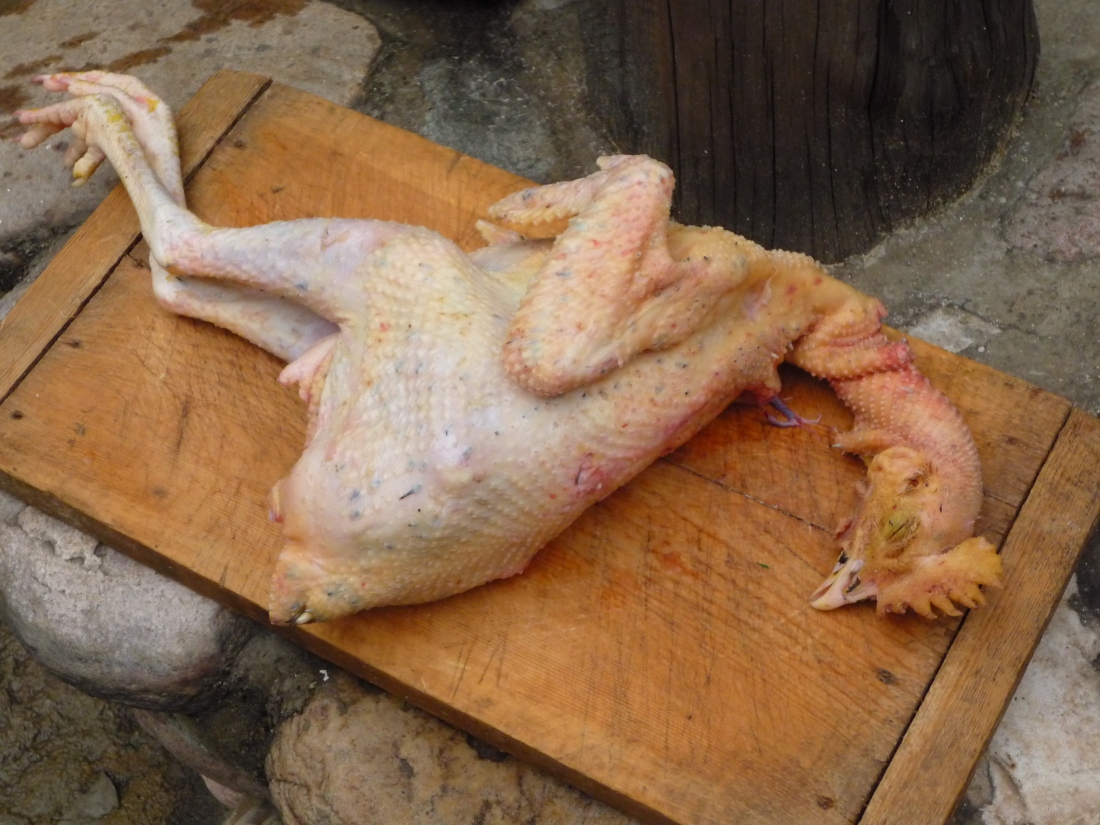This post is strictly not suitable for vegetarians.
You’ve been warned.
When I was in JiXian county with Aaron’s family, his father proposed to have chicken curry one evening. Curry is not a traditional Chinese specialty, but it’s become quite popular – curry paste is available in most supermarkets, and a chain of Taiwanese restaurants has curry beef or chicken as a standard option on their set meals. Now of course, in a Chinese village environment, the main excitement of chicken curry is all about the chicken.
It all starts with a drive along dirt roads, between brick walls or fields of pear trees. Untill you reach a particular house – known only to locals, no sign advertising poultry for sale here – and get off the car.
There’s a family standing in a courtyard: little boy eating something out of plastic wrapping, dog playing, and at the back, a huge netted area, with chickens running around. After a long discussion with the matron of the place, weighing options and selecting potential curry candidates, she gets into the pen, a large net in her right hand – like the ones used for catching butterflies. With a swift movement downwards, she traps the selected chicken inside, interrupting its wild run for life. She lifts it up by the wings, ties both feet together, and weighs it – alive – in rustic metal scales. 70 kuai later, the chicken is in the boot, quietly resting at the bottom of a blue plastic box.
A drive back to the village, and a stop at the village coordinator’s house – selected executor. He walks out to the river bank, holding the chicken in one hand; the other has a pair of scissors, old, rusty, blunt. The chicken is calmly put down on a clay pipe running along the river, and the village coordinator fumbles around its neck with the scissors, cutting off a few feathers first, then getting at the veins. Blood comes out, very slowly; the chicken’s eye closes, opens, goes upwards, closes again. It doesn’t resist, or scream. The village coordinator cuts a few more veins open; more blood comes out, but still slowly, quietly, not a gushing foutain, more like a drip. Then, the chicken goes limp, its eye doesn’t open again. The village coordinator washes it in the river, then brings it back inside the house. Blood and feathers cling to the clay pipe, unwashed.
Gender plays in. The village coordinator’s wife proceeds with feathering the dead animal, using boiling water, while you sit down on low stools and chat with her husband – sharing stories of a trip to Europe, discussing the defining features of a woman’s beauty, comparing Italian and Chinese customs. Fifteen minutes later, the chicken arrives, ready to consume – almost identical to what a Western city dweller will find in a supermarket, bar the plastic wrapping.
Back home, the chicken is cut into small pieces, and throw into a wok with onions, carrots and potatoes; then transferred to a larger pot with a bit of water, the curry paste, and half a can of coconut milk. Slow cooking, lid on. Twenty minutes or so, the chicken is ready to consume.
Having read that, maybe some people will choose the beef. I haven’t seen the killing method. What I saw was this. Sunday market in JiXian town centre, one lane has a few meat stalls: three selling pork, one selling beef. Unlike an Australian or French butcher’s display, this one proposes meat in its original state. On the bench, two legs of beef. You tell the seller which part of the leg you want meat cut off from, and she proceeds for you. The price varies, depending on the section chosen.
Gorish? Meat lovers, be reassured. Chinese city dwellers have their sensitivities too. Beef comes in all forms. And for those not enjoying the vision of beef flesh on the leg, they can try these little dry beef lollies, surprisingly popular.
How cute is the little cow. Notice the little poem? “May the breeze bring you the tenderness and warmth from me”. Crypto-christianism? Chew me, and I’ll be your strength.









